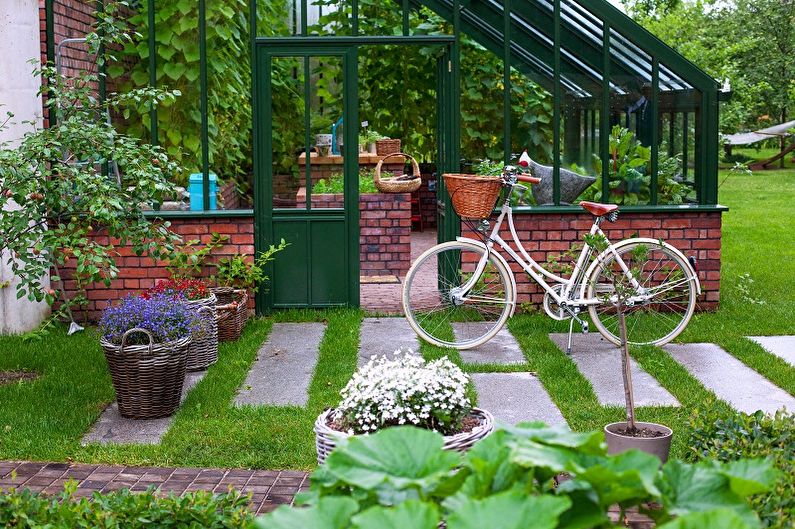
The paths for garden plots solve several problems at once - they make walking and transporting mechanized equipment easier, divide the space into zones and decorate it. In most cases, you can pave them yourself, you just select the necessary material. We suggest that you familiarize yourself with the main ways to create refined paths for a private yard!
1. Concrete slabs
Strong and reliable concrete is an excellent resource for organizing garden trails. The concrete version is easy to clean, it is economical, resistant to temperature changes and durable. In the finished form, the plates look pretty good, moreover, they can be made in almost any size and configuration. It is possible to change the shade of the coating by adding the necessary number of dyes. To build such tracks yourself is not difficult.
To begin, mark the borders and dig a bed 10 cm deep. Fill it with a 5 cm layer of sand, tamp and pour over water. Next, mount the wood frames in the bed with a distance between them of 7 cm. The width of the frames should be directly proportional to the width of the path itself. Fill the framework with concrete mortar.
After 3 days, the concrete slabs will harden. Now the matter remains small - plant grass between the planes or fill the gaps with pebbles.
Surfaces look beautiful and appropriate on areas decorated in a modern, Scandinavian style. A strict and somewhat cold image is combined with glass, plastic, stone, metal.



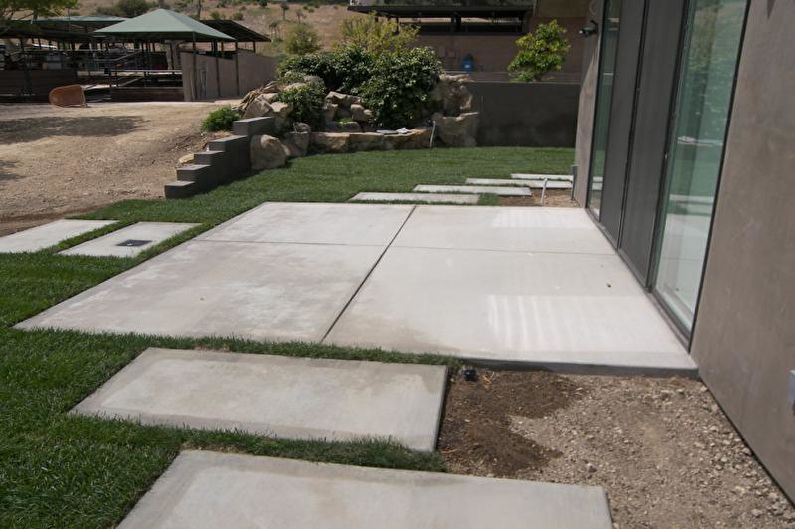
2. Boards
Wood is perfect for landscaping in any form. Wood is a warm natural material that does not overheat in hot weather, and therefore it is pleasant to walk on it even without shoes. Thus, if you are a fan of natural raw materials, feel free to use wood to create a garden path.
In the design process, it is worth paying special attention to the terrain. Watering places, deep depressions on which liquid can accumulate are not the most successful for timber. From a technological point of view, they should be placed above the soil line so that they remain dry and clean. Make a kind of pillow, laying the frame in a trench, which is subsequently secured with wood screws.
In order for the boardwalk to harmoniously fit into the general landscape, its dimensions should be proportional to the location. For example, a small area in the garden does not require wide lines, limit yourself to 50 cm for one person. The central passages, on the contrary, should be equipped with spacious routes of a meter or more in size.


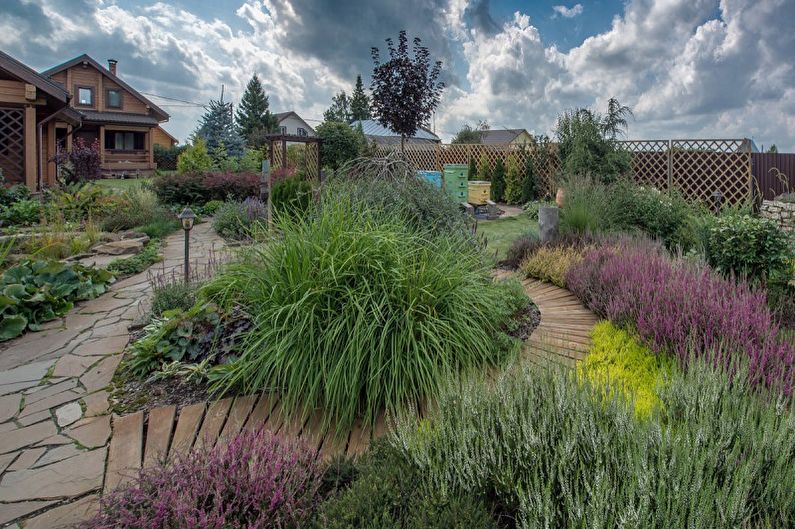
3. Wood chocks
Garden paths made of wood saw cuts are also not trivial. Environmentally friendly products have a natural appearance, low price, do not form puddles, are repaired, and over time, unsuitable logs can be crushed and included in compost. But the most significant plus is that a unique path can be quickly and easily built with your own hands.
To begin, mark the route and mark it with stakes and ropes stretched between them. Dig a moat, which should be 70-80 mm larger than the height of the stumps. Put plastic wrap on the bottom. Then pour gravel or crushed stone at half the total height, tamp it well. Fill the remaining space with sand and pour it to seal.
Next, the saws themselves are laid out. Stack logs as you like, large and small stumps can be alternated, position them close or far from each other.The most important thing at this stage is to secure them and level them with a building level.
At the end, fill the space between the discs with grassy seeds, sand or gravel. Treat the wooden parts themselves with an antiseptic, cover with paint, or with linseed oil.
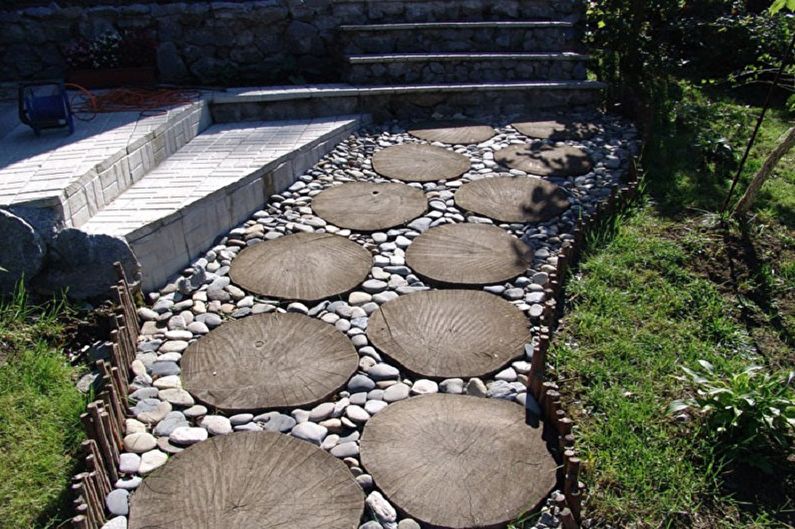
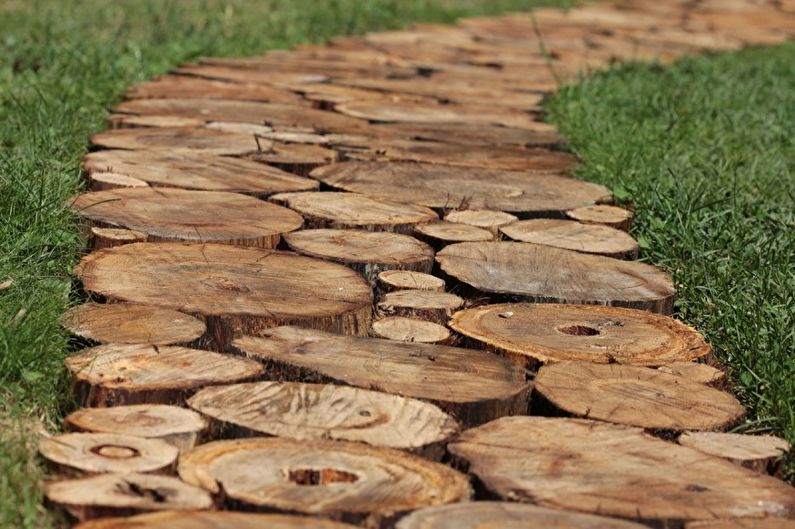


4. Curly shapes
Using curly shapes is a simple and inexpensive way to equip a garden path. For a full cycle of self-construction, just one device is enough. Naturally, the slabs are not as strong as the factory products manufactured with vibrocasting technology, but for landscape paths with their low load, this is quite the best option.
The frame can be purchased in a specialized store, on the Internet resource, or made it yourself from polystyrene or chipboard. Concrete mortar should be relatively common. Place the frame on the ground, fill it with concrete, distribute with a spatula and wait 10-15 minutes until the liquid hardens. Use gentle vibration to remove the mold. Repeat the cycle over the entire intended area. At the end, fill the blocks with sand, pour over water and sweep with a stiff brush.
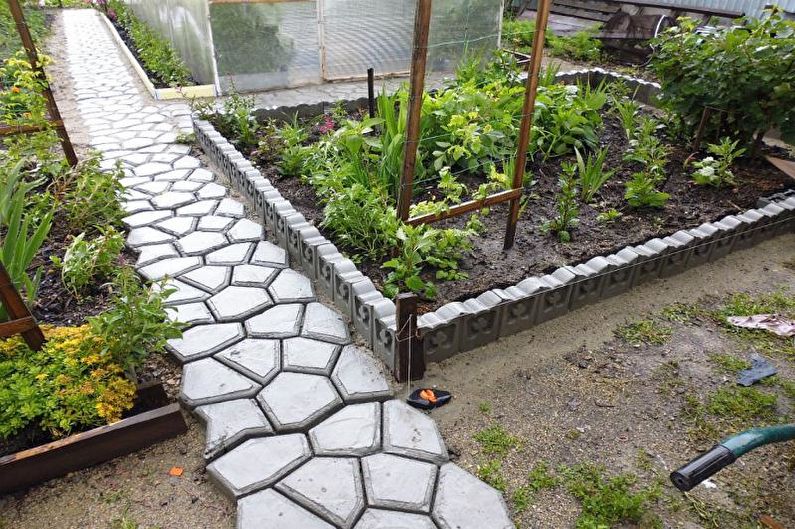
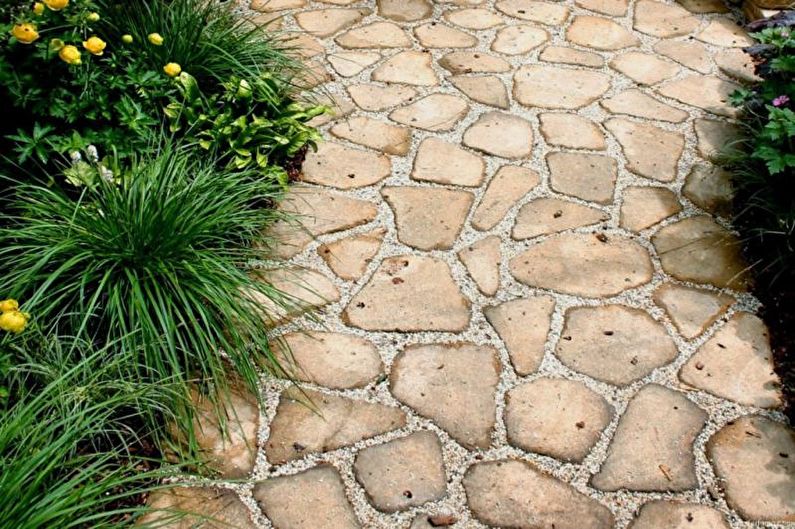

5. Natural stone
For many designers, this material seems to be one of the best in its practical and aesthetic characteristics. Indeed, surrounded by bushes, trees, flowers and lawns look very natural. For consumers, the appropriateness of using these products can be doubtful except because of the considerable prices and processing difficulties.
The stone is beautiful in its naturalness, so it is better to leave it in its original form, otherwise you run the risk of getting an artificial unremarkable result instead of a noble image. Especially popular are products from basalt, granite, marble and limestone slabs.
There are two main methods of masonry - with or without cement. In any case, it is worth deciding before starting work. When laying the topcoat, make sure that the canvas is a few centimeters above the ground. It is important to pay attention to this so that the liquid does not accumulate on the finished track.
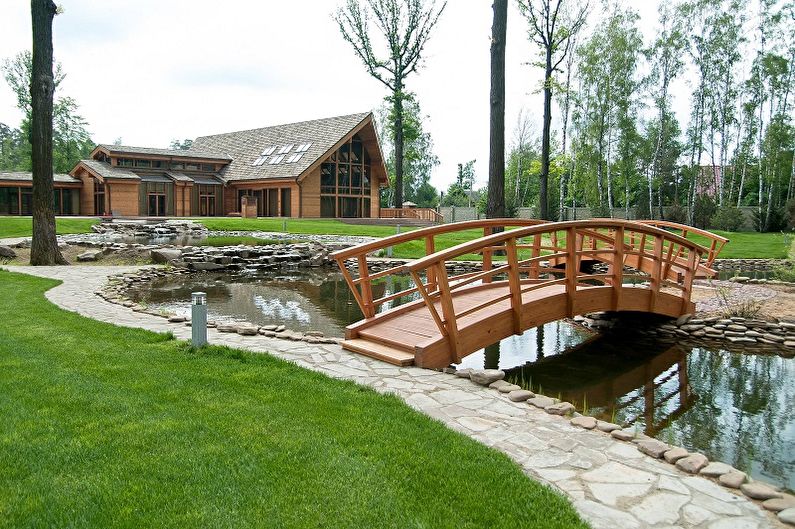



6. Clinker pavers
Cobblestone sidewalks are resistant to weather conditions, mechanical stress and wear. Attractive appearance and a nice color palette along with low prices make this material quite competitive in the construction market. The products are convenient in installation and operation, they are not destroyed by acids, salts and oils, and the shade remains the same for many years.
Among the main groups of shades, the following can be distinguished: brick, yellow, dark and light - choose the right color to match the rest of the buildings. An important factor is the texture of the product. Stay smooth, rough, or decorative with shiny elements. But be careful, even the texture should overlap with the facade.
You can build a garden path from paving stones without the help of specialists. Remove the topsoil by 30-50 cm. A sandy foundation is sufficient for hiking trails. It is filled up by 10-20 cm, filled with water and compacted. Next, make a small depression and set the curb 2-4 mm below the pavers. Choose the laying method and proceed to the laying process itself, leaving small gaps of 3-5 mm. At the end, fill the cracks with sand, spread it with a brush, ram the plate with a vibrating plate and wash the plane with water.
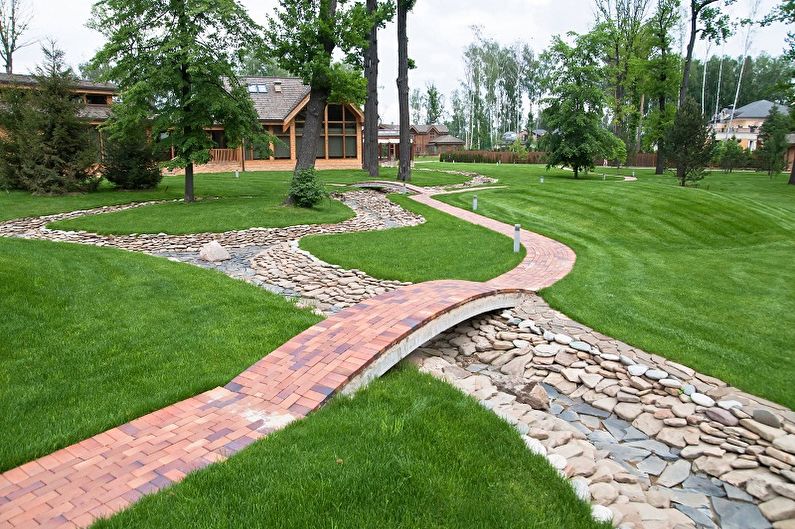


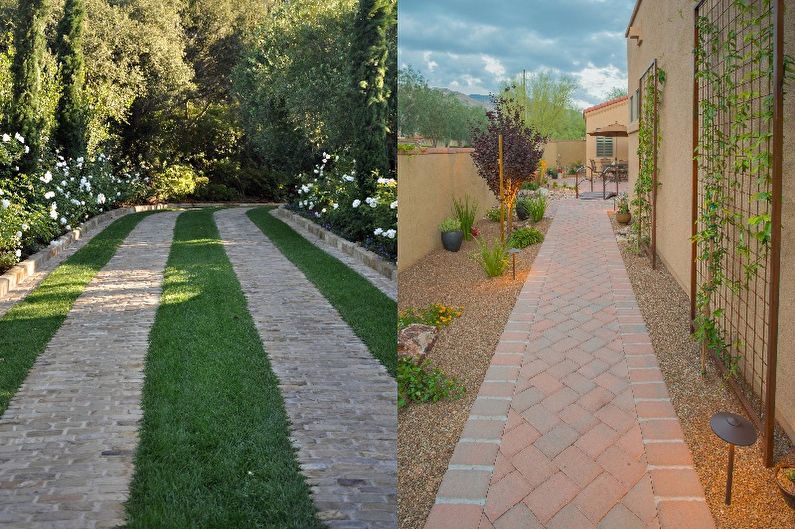
7. Bulk path
Specialists in the field of landscape design have long used pebbles, gravel and gravel in their work. Sites in the company of these stones look beautiful and relaxed. At the same time, the paths calmly respond to feasible loads in the form of carts and walking. Be sure to pay attention to bulk variations if your home is decorated in a rustic or Mediterranean style.Country garden will organically complement the paths from the debris of rocks, laid in a continuous canvas, without excessive gloss. In the second case, you can slightly refine and lay out a mosaic pattern of pebbles. Moreover, an alpine hill, beautiful flower beds or a small pond go well with this design element.
If you wish, you can build a garden path from pebbles with your own hands. Define the contours with a rope, taking into account that their width should be at least 50 cm. Remove the soil layer by 15-20 cm, fill in the sand, and then crushed stone. Fill the moat with two-thirds. Align the curb along the edges and fill the remaining space with cement, controlling the horizontal orientation level. Spread pebbles on a wet solution. For laying stones without ornament, place them vertically or horizontally close to each other, pressing them into the cement. If you want to organize a track with a picture, create a sketch and start sketching it from the center. To get an even plane, use a board and a hammer, tapping each area, check the result with a level. After covering the work with film, leave it for a day, and then fill the path with liquid cement, and remove the excess with a brush. You can use the track for its intended purpose after 15 days.
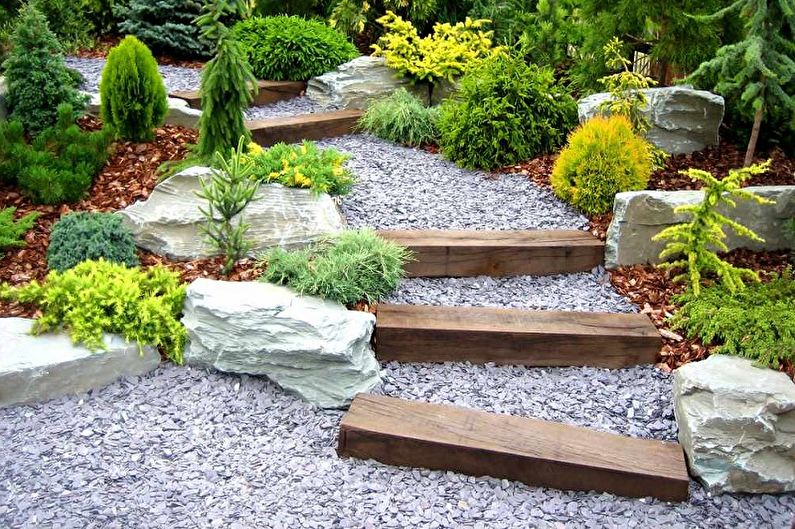
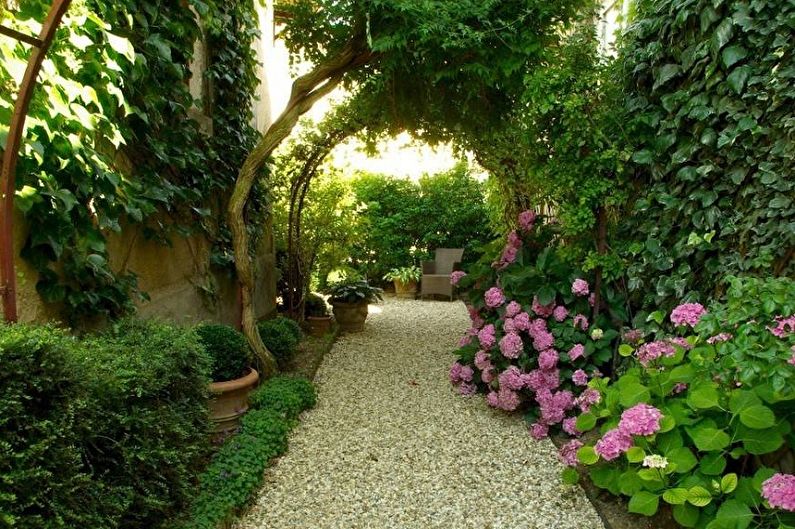
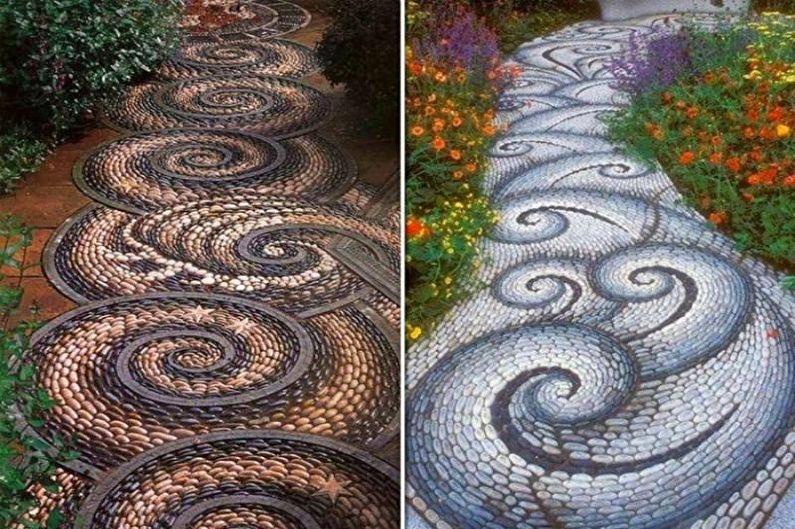
8. Garden flooring
Garden flooring is a relatively new coating for landscaping. As a rule, it is a solid or modular platform made of wood or KDP. He has already established himself as an aesthetic, convenient and safe resource. When choosing a flooring made of natural wood, give preference to oak species, as they are smaller, for example, conifers, are subject to decay and wear.
Laconic configuration is almost the main advantage of the material. If there is a solid base with drainage, you can lay the canvas directly on the ground. But if the surface has bends, and you plan to ennoble a large space, it makes sense to prepare a base like a sand or sand and gravel pillow.
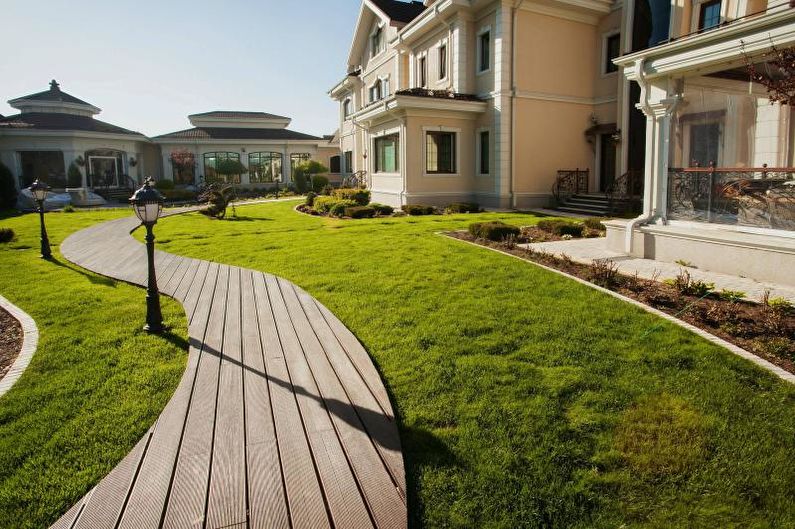
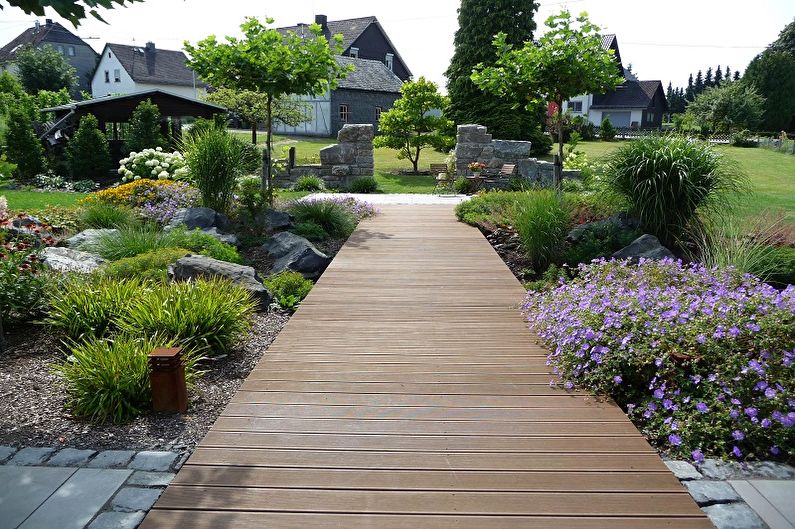

Master class: DIY garden path


